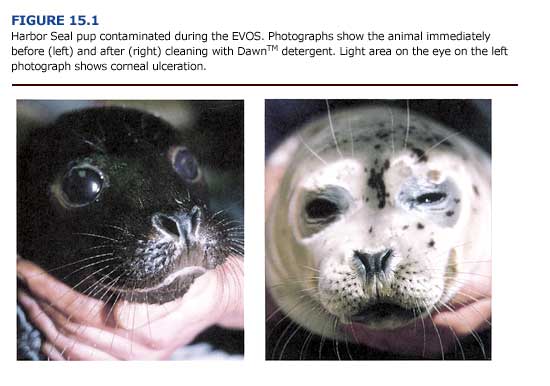The selection of appropriate chemicals for cleaning fur or hair is often constrained by logistics, supply, and local availability. The use of Dawn™ detergent has been recommended for cleaning oiled sea otters (Chapter 6) and is probably appropriate for oiled pinnipeds (Figure 15.1) and polar bears. Another product that has proved effective is CT 18® concentrated cleansing gel (Chemtech Products, Australia). It is a neutral pH, nonionic detergent with a phosphate buffering system that works well in salt water and causes little irritation to skin and mucous membranes. Furthermore, it is a nonsolvent and biodegradable. Two washes with CT 18® removed 90% of the oil from fur seal pups, but left a detergent residue even after rinsing. The animals were subsequently sprayed with Preen Trigger Prewash Spray (Samual Taylor, Australia), and this powerful de greaser was massaged into the fur before being rinsed off. Preen® contains a low odor aliphatic hydrocarbon solvent and less than 20% by weight of a nonionic degradable surfactant (alcohol ethoxylates). Preen® successfully removed the detergent residue (Gales 1991).

Davis and Anderson (1976) used several detergents on gray seal pups in Wales. They found that Winfield® detergent liquid and BP 1100X® were the most effective, although the latter was less effective against weathered oil.
To effectively clean an animal, the detergent must be thoroughly worked into the fur. This can be accomplished using a stiff bristled hair brush for both the washing and rinsing steps. The number of washes and rinses will depend on the effectiveness of the detergent and how much oil is on the animal. Oiled fur seal pups needed three wash-rinse cycles that took approximately thirty minutes per animal (Gales, 1991). A high volume supply of clean water greatly facilitates the cleaning procedure. In the field this can be achieved through the use of high pressure water pumps. Cleaning stations should be situated far enough from the major seal haul out site to minimize disturbance.
The need to dry the animals will depend on the ambient conditions. It is probably less critical to dry pinnipeds than the more thermally sensitive polar bears or sea otters.
Washing animals should only be attempted when the risk of recontamination has been removed or significantly reduced. Clean-up operations may be able to deal with oil on the shore more easily than on nursing mothers, which readily transfer oil to their pups. Davis and Anderson (1976) discontinued their cleaning efforts partly because of maternal recontamination.

